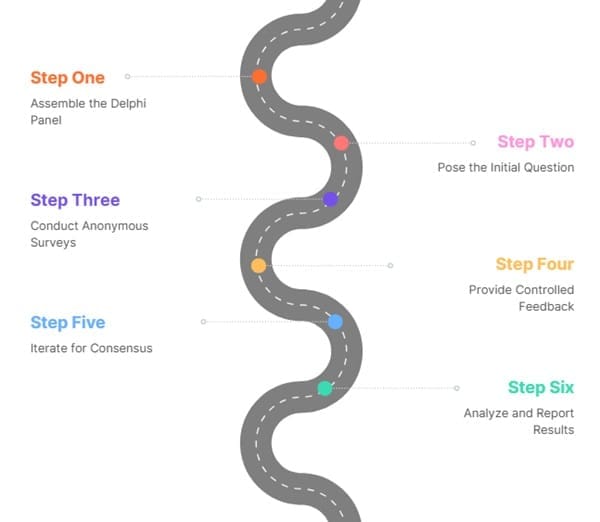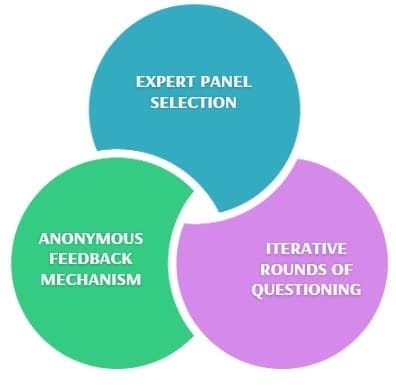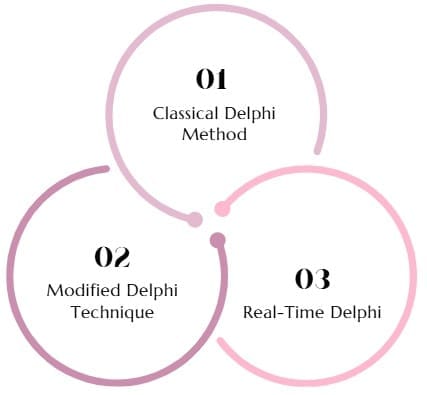The Delphi technique stands as one of the most sophisticated and widely-used methods for gathering expert opinions and achieving consensus on complex issues. Named after the ancient Oracle of Apollo at Delphi in Greece, this structured communication technique harnesses collective wisdom to make informed decisions and predictions about uncertain future events.
Originally developed by Norman Dalkey and Olaf Helmer at the RAND Corporation in the 1950s, the Delphi method has evolved into an essential tool across numerous industries. From healthcare research to project management, this approach transforms individual expert knowledge into reliable group insights through systematic rounds of questioning and feedback.
Unlike traditional brainstorming sessions or face-to-face meetings, the Delphi process maintains anonymity among participants while facilitating structured dialogue. This unique characteristic eliminates the influence of dominant personalities and reduces groupthink, allowing each expert’s genuine opinion to emerge naturally.
What is the Delphi Technique?
The Delphi Technique is a structured forecasting and decision-making method that relies on a panel of experts to provide informed opinions through iterative rounds of anonymous feedback. Unlike traditional group discussions, the Delphi method minimizes bias by keeping responses confidential, allowing participants to focus on ideas rather than personalities.
This approach is widely used in fields like project management, policy development, and research to predict outcomes, identify priorities, or resolve complex issues.
The technique’s core strength lies in its ability to refine opinions over multiple rounds, fostering consensus while respecting diverse perspectives. By combining anonymity, controlled feedback, and statistical analysis, the Delphi process ensures robust, reliable results.
Origins of the Delphi Technique
The Delphi method draws its name from the Oracle of Apollo in ancient Delphi, a sacred site in Greece where priestesses delivered prophecies. While the modern technique is far from mystical, its name reflects its goal of uncovering insights through collective wisdom.
Developed in the 1950s by the RAND Corporation, the Delphi study was initially designed to forecast technological advancements during the Cold War. Researchers Norman Dalkey and Olaf Helmer sought a method to aggregate expert opinions without the pitfalls of groupthink or dominant personalities, giving birth to the Delphi methodology.
Today, the Delphi approach is used globally across industries, from healthcare to urban planning, proving its versatility and enduring relevance.
Public, Onsite, Virtual, and Online Six Sigma Certification Training!
- We are accredited by the IASSC.
- Live Public Training at 52 Sites.
- Live Virtual Training.
- Onsite Training (at your organization).
- Interactive Online (self-paced) training,
How Does the Delphi Technique Work?

The Delphi process is both systematic and iterative, designed to distill expert knowledge into actionable insights. Here’s a step-by-step breakdown of how it works:
Step 1: Assemble the Delphi Panel
The process begins by selecting a diverse group of experts with relevant knowledge in the subject area. This Delphi panel typically includes professionals, academics, or stakeholders who can provide valuable perspectives. The panel size varies but often ranges from 10 to 50 participants, depending on the study’s scope.
Step 2: Pose the Initial Question
A facilitator designs a clear, focused question or problem statement to guide the process. For example, in Delphi technique project management, the question might be, “What are the key risks in implementing a new software system?” The question sets the stage for all subsequent rounds.
Step 3: Conduct Anonymous Surveys
Participants respond to the question anonymously through surveys or questionnaires. Anonymity is critical in the Delphi method of forecasting, as it prevents bias, encourages honest input, and reduces the influence of dominant personalities. Responses are collected and analyzed by the facilitator.
Step 4: Provide Controlled Feedback
After the first round, the facilitator summarizes the responses, highlighting areas of agreement and divergence. This feedback is shared with the panel, often including statistical measures like medians or ranges. Participants review the summary and refine their answers in subsequent rounds.
Step 5: Iterate for Consensus
The Delphi study typically involves two to four rounds of surveys. In each round, experts adjust their responses based on the group’s feedback, moving closer to a consensus. The process continues until a predefined level of agreement is reached or diminishing returns are observed.
Step 6: Analyze and Report Results
Once consensus is achieved, the facilitator compiles the final results into a report or actionable recommendations. The Delphi consensus provides a clear, evidence-based foundation for decision-making or forecasting.
Also Read: Nominal Group Technique (NGT)
Core Components of the Delphi Process

Expert Panel Selection
The foundation of any successful Delphi study rests on assembling the right panel of experts. Researchers typically select 10-50 participants who possess deep knowledge in the subject area. These panelists must demonstrate proven expertise, relevant experience, and the ability to think critically about future scenarios.
Panel diversity often enhances the quality of results. Including experts from different backgrounds, geographical locations, and organizational perspectives enriches the collective knowledge pool. However, maintaining anonymity throughout the process ensures that individual opinions remain unbiased by external influences.
Iterative Rounds of Questioning
The Delphi process unfolds through multiple rounds of carefully designed questionnaires. Each round builds upon previous responses, gradually refining group consensus while identifying areas of disagreement. This iterative approach allows participants to reconsider their initial positions based on collective feedback.
Typically, three to four rounds prove sufficient for most studies. The first round often uses open-ended questions to explore the topic broadly. Subsequent rounds employ more structured formats, including ranking exercises, probability estimates, and Likert scales to quantify expert opinions.
Anonymous Feedback Mechanism
Anonymity serves as the cornerstone of effective Delphi research. Participants never know the identity of other panel members, which eliminates social pressure and encourages honest responses. This feature distinguishes the Delphi method from traditional consensus-building approaches.
Between rounds, researchers compile and summarize all responses, sharing this collective feedback with participants. This transparency allows experts to understand the group’s overall perspective while maintaining individual anonymity. As a result, participants can adjust their views based on new insights without losing face or credibility.
Types of Delphi Techniques

Classical Delphi Method
The traditional approach follows strict anonymity protocols and relies entirely on written questionnaires. Participants never interact directly, and researchers maintain complete separation between rounds. This method works exceptionally well for controversial topics or situations where personality conflicts might interfere with objective analysis.
Classical studies often require several months to complete, as researchers need time to analyze responses thoroughly between rounds. However, this extended timeline allows for deeper reflection and more considered responses from participants.
Modified Delphi Technique
The modified Delphi method introduces flexibility into the traditional framework. Researchers might begin with a structured first round instead of open-ended questions, or they may allow limited interaction between participants. Some studies combine face-to-face meetings with anonymous questionnaires.
This adaptation speeds up the research process while maintaining core Delphi principles. Organizations often prefer modified approaches when time constraints limit the feasibility of classical methods. Project managers frequently employ modified techniques during risk assessment and resource planning activities.
Real-Time Delphi
Technology has enabled real-time Delphi implementations using online platforms and mobile applications. Participants can submit responses immediately, view updated group statistics, and modify their answers continuously. This dynamic approach significantly reduces study duration while maintaining anonymity.
Real-time systems often include visualization tools that help participants understand complex data patterns. Interactive dashboards display consensus levels, statistical distributions, and trend analyses in user-friendly formats.
Also Read: Benefits Of Six Sigma Green Belt Training
Benefits of the Delphi Technique
The Delphi method offers several advantages that make it a preferred choice for complex decision-making:
- Anonymity Reduces Bias: By keeping responses confidential, the Delphi technique minimizes groupthink and ensures honest, unbiased input.
- Iterative Refinement: Multiple rounds allow participants to refine their opinions, leading to more accurate and reliable outcomes.
- Diverse Expertise: The Delphi panel brings together varied perspectives, ensuring a well-rounded view of the problem.
- Flexibility: The Delphi approach can be adapted to virtually any field, from Delphi technique project management to academic research.
- Consensus-Driven: The process fosters agreement, making it easier to align stakeholders on critical decisions.
Challenges and Limitations
While powerful, the Delphi technique isn’t without challenges. Facilitators must carefully design questions to avoid ambiguity, and the process can be time-consuming due to multiple rounds. Additionally, selecting a truly representative Delphi panel is critical—excluding key perspectives can skew results. Finally, achieving true consensus may be difficult if experts hold strongly divergent views.
The Modified Delphi Method
The modified Delphi method introduces variations to the traditional approach to suit specific needs. For example, instead of starting with an open-ended question, facilitators might provide a pre-set list of options to streamline the process. In some cases, the modified Delphi technique incorporates face-to-face discussions in later rounds to accelerate consensus. This flexibility makes it ideal for time-sensitive projects or when working with smaller groups.
Example
Imagine a tech company planning to launch a new product. The project manager uses the Delphi technique example to assess market viability. In the first round, a panel of marketers, engineers, and industry analysts responds to the question, “What factors will drive consumer adoption of this product?”
Responses highlight price, features, and brand reputation. In the second round, the facilitator shares these insights, prompting experts to rank the factors. After three rounds, the panel agrees that innovative features and competitive pricing are the top drivers, guiding the company’s marketing strategy.
The Delphi Technique vs. Other Methods
How does the Delphi method compare to other decision-making approaches? Unlike brainstorming sessions, which can be chaotic and dominated by vocal participants, the Delphi group technique ensures equal input through anonymity. Compared to surveys, the Delphi process is more dynamic, allowing for iterative refinement.
However, it requires more time and coordination than simple polls, making it best suited for complex, high-stakes decisions.
FAQs on Delphi Technique
What is the Delphi Technique in project management?
The Delphi technique in project management is a method used to gather expert opinions anonymously to assess risks, allocate resources, or plan projects. It involves iterative surveys to achieve consensus, ensuring unbiased and reliable outcomes.
What is a Delphi study?
A Delphi study is a research method that uses structured, anonymous surveys to collect expert opinions on a specific topic, refining responses over multiple rounds to reach a consensus.
How does the Delphi method differ from traditional surveys?
Unlike traditional surveys, the Delphi method involves multiple rounds of feedback, allowing experts to refine their responses based on group insights. It emphasizes anonymity and consensus-building.
Where is Delphi located, and why is it significant?
Delphi is a historic site in Greece, near the modern town of Delphi, famous for the Oracle of Apollo. The Delphi Technique draws its name from this ancient site, symbolizing wisdom and foresight.
What is the modified Delphi method?
The modified Delphi method adapts the traditional process by incorporating variations, such as pre-set questions or hybrid discussions, to suit specific project needs or time constraints.
Final Words
The Delphi Technique is a timeless tool that transforms expert opinions into actionable insights. From its roots in the Delphic Oracle to its modern applications in project management, forecasting, and research, this method empowers teams to tackle complex challenges with confidence. By fostering anonymity, iterative refinement, and consensus, the Delphi process delivers reliable, bias-free results.

About Six Sigma Development Solutions, Inc.
Six Sigma Development Solutions, Inc. offers onsite, public, and virtual Lean Six Sigma certification training. We are an Accredited Training Organization by the IASSC (International Association of Six Sigma Certification). We offer Lean Six Sigma Green Belt, Black Belt, and Yellow Belt, as well as LEAN certifications.
Book a Call and Let us know how we can help meet your training needs.




















